





|
Flash Energetic |
1 |
|
Science Club... |
2 |
|
Reportage n. 1 |
3 |
|
Reportage n. 2 |
4 |
|
The river Muson |
5 |
|
A scchool day outdoors |
6 |
|
Can we endure the challenges of nature? |
7 |

|
FIELD TRIPS |


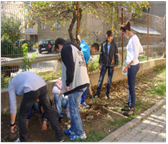
|
“”We were green and we had fun too!” .” |
|
After a lesson about BIODIVERSITY, our Biology teacher, Mrs Carmen Vochițu, organized a contest of posters related to our lesson and the project. Drăgoi Beatrice, , XI H |
|
On the 29th of November, on the day called ”The Green Day”, a team of students coordinated by Mrs Mirela Uțã planted some plants and shrubs in the court yard of the high-school. |

|
During Biology and Computer Science classes, my colleagues realized posters, articles, logos about biodiversity, environment, nature.
|
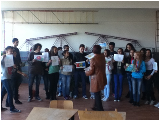


|
Our target is to measure the seasonal changes in the marshes around our town. There are a lot of them with a high level of salinity. It’s something very characteristic in our area. We want to differentiate the changes by season in the different zones of a marsh: Always flooded. Always dry. Half flooded half dry. Also we are going to take into account the levels of salinity in the ground. For this studio they will use the square meter method.
This method consists in throwing away sometimes a wooden square meter over a vegetated area each time in the same place. |

|
Firstly we have been practicing in our high school's garden, with a wooden square meter and we have tried to indentify in the lighten zones (TEST Nº1) and not so lighten ones(TEST Nº 2). |
|
These are the results of our first experience
|
|
After that we have appreciated some mistakes and materials that they are also necessary to do the research in a correct way. We think that at the end of this course we are going to do a report with the different changes in each season in different areas of a marsh. Also we are going to take into account the levels of salinity in the ground.
If we could catalogue the species and their development during the time of this research it would be fantastic, but we aren’t sure about this.
|
|
‘...a group of teachers had the idea of creating a Science Club with students interested in this area…’ |

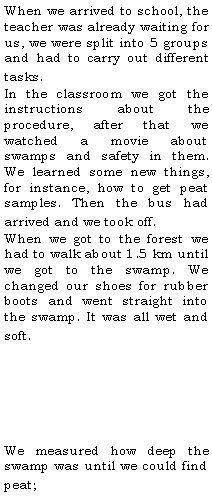
|
next, we had to find out how cold it was in the swamp - both the air and the soil, in some places the ground was still frozen. The major task was to find out how many trees were around 25 m zone. We discovered some small spruces and pine trees. The task finished, we got back to school and made the presentations. Overall, I think it was really fun, a lot more fun than just sitting in school all day. Dāvis Valka Gymnasium, |


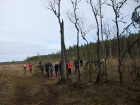
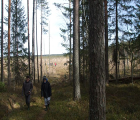


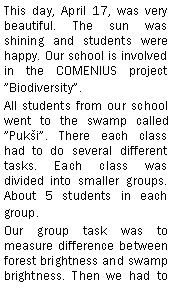
|
provide all data from each group in our class and make a presentation. Now we know that next time when we go to swamp we should wear appropriate clothes. Despite the fact that it was difficult to walk, it was really funny and interesting to do the tasks. And we think we should visit the swamp next winter, because then we would see the beauty of swamp in winter and will get some new experience. Gusts and Toms Valka Gymnasium, Latvia |


|
….I think it was really fun, a lot more fun than just sitting in school all day. |
|
...we think we should visit the swamp next winter, because then we would see the beauty of swamp in winter and will get some new experience. |

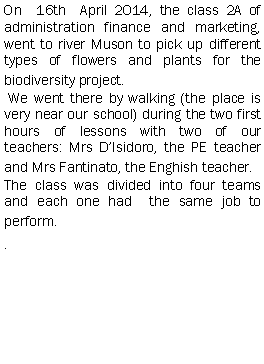
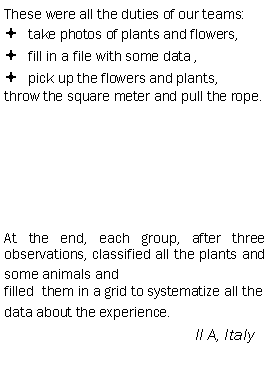
|
‘….went to river Muson to pick up different types of flowers and plants for the biodiversity project’ |









|
...With a little help from all you can do great things! |
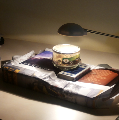
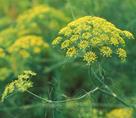
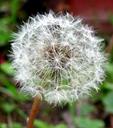



|
...If we could catalogue the species and their development during the time of this research it would be fantastic..... |

|
Yes, the five students and two teachers from Valka Gymnasium can proudly voice their yes as they spent 7 days on Hiposari island in Ladoga lake in Karelia. There they could enjoy the nature, test themselves living in tents without mobiles, TVs, computers, electricity, showers and other daily things. There were young people from Latvia, Estonia and Russia, they learned sailing from experienced instructors. The greatest challenge was to get back to the island in the thunderstorm, then they had to row, change sails, pour out water and follow the captain’s commands. They did it. They learned not to give in, to support each other, and came home being more mature. Dārta Lozda, grade 11.b |
|
SPECIES |
TEST Nº1 |
TEST Nº2 |
|
% |
% |
|
|
Stenotaphrum secundatum |
90 |
86 |
|
Malva silvestris |
8 |
6 |
|
Poa pratensis |
|
1 |
|
Lolium sp. |
|
2 |
|
Senecio vulgaris |
|
2 |
|
Cynodon dactylon |
|
1 |
|
Trifolium so. |
|
2 |
|
Land |
2 |
|